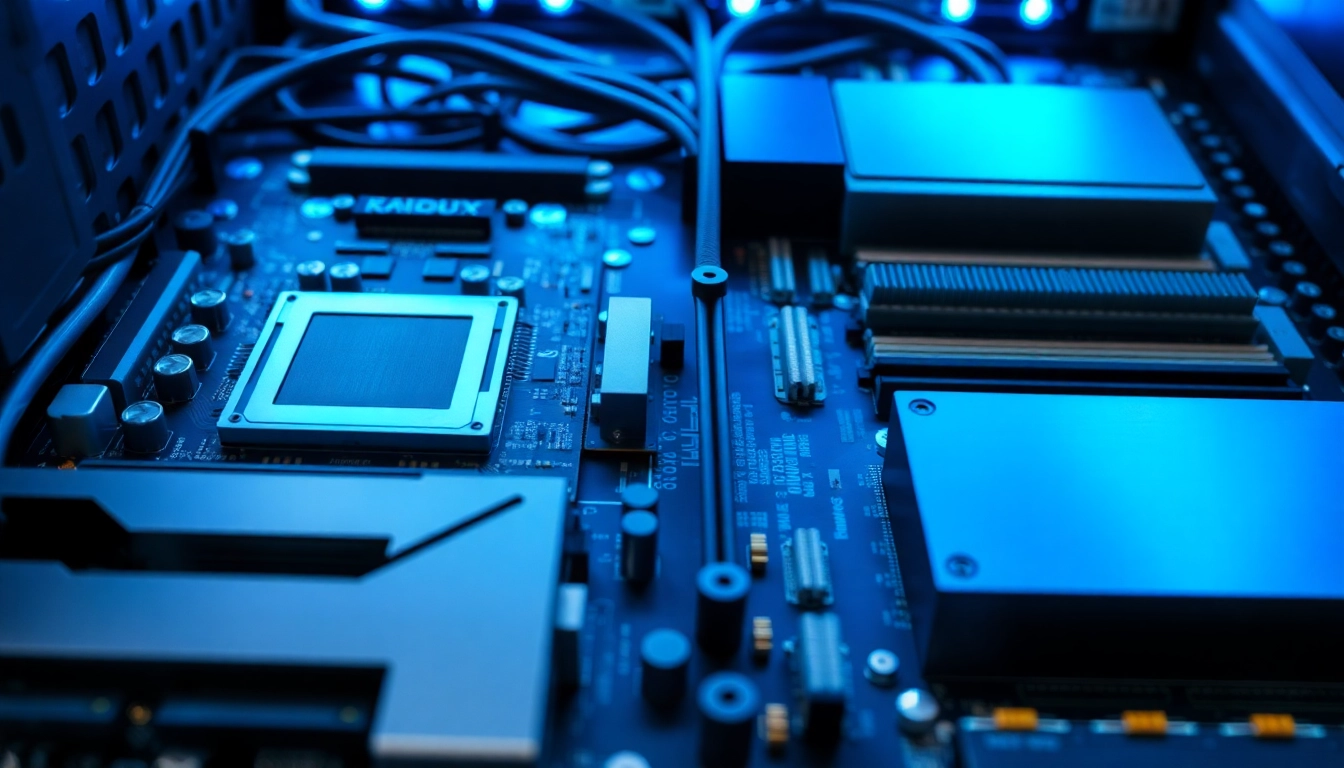Introduction to Server Components
Understanding the essential componente server is foundational for designing, maintaining, and optimizing robust server infrastructure. These components collectively contribute to the performance, reliability, scalability, and security of servers that power enterprise applications, cloud services, and data centers. In this comprehensive guide, we’ll delve systematically into each core element, exploring their functions, types, selection criteria, and best practices for deployment and maintenance.
Whether you are a system administrator, IT manager, or hardware enthusiast, grasping the intricacies of server components provides the insight needed to make informed decisions. This not only ensures optimal operational efficiency but also future-proofs your investments in hardware technology.
Hardware Essential in a Component Server
2.1 Processors and CPU for High-Performance Servers
The Central Processing Unit (CPU) is the brain of any server, executing instructions and managing data processing. For demanding environments, high-performance processors such as Intel Xeon or AMD EPYC series are standard. These CPUs feature multiple cores—up to 64 or more—allowing parallel processing and improving throughput. For example, the Dell PowerEdge R640 server is equipped with dual Intel Xeon Gold 6132 processors, each with 14 cores, ensuring substantial processing power for virtualization, database management, or AI workloads.
When choosing CPUs, focus on core count, clock speed, cache size, and compatibility with your motherboard. Optimize for workloads—such as real-time analytics or big data—that require intensive computation. Modern processors also support features like hyper-threading, which further enhances performance by executing multiple threads per core.
2.2 Memory (RAM) and Its Critical Role
RAM serves as the short-term memory of the server, facilitating fast data access for running applications and processes. For business-critical applications, a minimum of 32GB RAM is recommended, with enterprise servers often requiring 128GB or more. For instance, the Dell PowerEdge R630 incorporates up to 128GB DDR4 RAM, crucial for handling large in-memory databases or multiple virtual machines simultaneously.
The selection of RAM impacts not only speed—driven by DDR4 frequencies up to 3200 MHz—but also stability. ECC (Error-Correcting Code) memory is essential for detecting and correcting data corruption, thereby increasing overall reliability. Future scalability should also be considered, with motherboards supporting additional memory modules for expansion.
2.3 Storage Solutions: SSDs, HDDs, and Hybrid Architectures
Storage performance and capacity are fundamental to a server’s responsiveness and uptime. Solid-State Drives (SSDs), such as Dell’s SATA SSD D3-S4520 480GB, offer lightning-fast data access, crucial for transactional systems, virtualization hosts, and large-scale web services. HDDs like Seagate Constellation ES.3 ST3000NM0023 are more suitable for archival or bulk storage, providing high capacity at lower costs.
Hybrid solutions, combining SSDs and HDDs, enable optimized performance and storage economy. For example, an enterprise could use SSDs for active data and HDDs for backup or long-term storage, creating a tiered architecture that maximizes efficiency. In deploying storage controllers, devices like Broadcom MegaRAID 9440-81 provide advanced RAID configurations, enhancing data integrity and redundancy.
Advanced and Complementary Server Components
3.1 Storage Controllers: Tri-Mode SAS/SATA/NVMe
Modern storage controllers like Broadcom LSI MegaRAID 9440-81 support tri-mode storage, enabling compatibility with SAS, SATA, and NVMe drives. These controllers are pivotal for managing multiple storage devices, ensuring data redundancy, and optimized throughput. NVMe SSDs, such as Dell D3-S4520, leverage the PCIe interface for superior speed, essential for data-heavy applications.
Implementing efficient controllers ensures that data flows seamlessly, reducing bottlenecks and latency. Configuration choices—such as RAID levels—should align with your performance and redundancy requirements. Technologies like cache acceleration further enhance responsiveness.
3.2 Network Interface Cards (NICs): High-Capacity Connectivity
Connectivity is vital for server performance and availability. High-speed network cards like Intel XXV710-DA2 Dual Port 25Gb SFP28 support rapid data transfer, reducing latency and increasing throughput. These NICs are essential for data centers handling large volumes of network traffic or distributed storage systems.
Selecting NICs with features such as offloading, virtualization support, and multi-port capabilities enhances scalability. Proper configuration of network settings, VLANs, and bonding ensures redundancy and load balancing.
3.3 Power Supplies and Redundancy
Reliable power sources are non-negotiable in server environments. Redundant power supplies, like those used in Dell PowerEdge servers, prevent downtime caused by power failures. Features like hot-swappable units contribute to maintenance without system shutdowns.
Efficient power supplies also minimize energy consumption and thermal output. High-quality units with certification standards such as 80 PLUS Gold or Platinum offer optimal efficiency and longevity.
Installation, Configuration, and Maintenance of Server Components
4.1 Efficient Assembly of Components
Proper assembly starts with meticulous planning. Ensure compatibility between processors, memory modules, and motherboards. Use anti-static precautions and high-quality tools to avoid damage during installation. Modular design, such as hot-swappable drives and power supplies, simplifies maintenance.
Documentation of hardware configurations facilitates troubleshooting and future upgrades. Implementing cable management best practices improves airflow, reducing thermal issues and prolonging component lifespan.
4.2 Performance Optimization Strategies
Fine-tune BIOS and firmware settings according to manufacturer specifications. Enable features like Hyper-Threading, turbo boost, and virtualization extensions. Use enterprise-grade operating systems and updated drivers to harness hardware capabilities fully.
Regular benchmarks and stress testing, utilizing tools like Intel Extreme Tuning Utility and mixed workloads, help identify bottlenecks. Adjust fan profiles and power schemes for optimal thermal and power efficiency.
4.3 Monitoring and Updating for Sustained Efficiency
Implement proactive monitoring solutions that track temperature, voltage, and component health. Software like Dell OpenManage or HP Insight Control provides real-time alerts for early diagnosis.
Firmware and driver updates are critical to maintaining security and compatibility. Additionally, periodic hardware audits ensure that ageing components are replaced before failures occur, safeguarding uptime and data integrity.
Emerging Trends and Best Practices in Server Components
5.1 Innovations in Storage and Networking Technologies
Advancements such as NVMe over Fabrics (NVMe-oF) enable remote high-speed storage access, reducing latency in distributed environments. 25GbE and 100GbE networking are increasingly replacing traditional Ethernet standards, supporting higher data rates.
Software-defined storage (SDS) and hyper-converged infrastructure (HCI) are revolutionizing deployment flexibility and resource allocation. These approaches combine hardware and software for scalable, cost-effective solutions.
5.2 Choosing Durable and Scalable Components
Durability is assured through enterprise-grade components with extended warranties and rigorous testing. Scalable systems support modular upgrades—adding blades, drives, or expanding memory—without significant downtime. When selecting components, consider future growth and compatibility with upcoming standards.
5.3 Certified Use Cases and Examples
Leading organizations deploy Dell PowerEdge R640 with dual Intel Xeon Gold processors and 128GB DDR4 RAM for high-performance computing tasks. Similarly, HPE ProLiant ML110 Gen10 is favored in small-to-medium enterprise settings for its reliability and expandability.
These examples demonstrate the importance of selecting validated components tailored to specific workload demands, ensuring optimal reliability and longevity.



